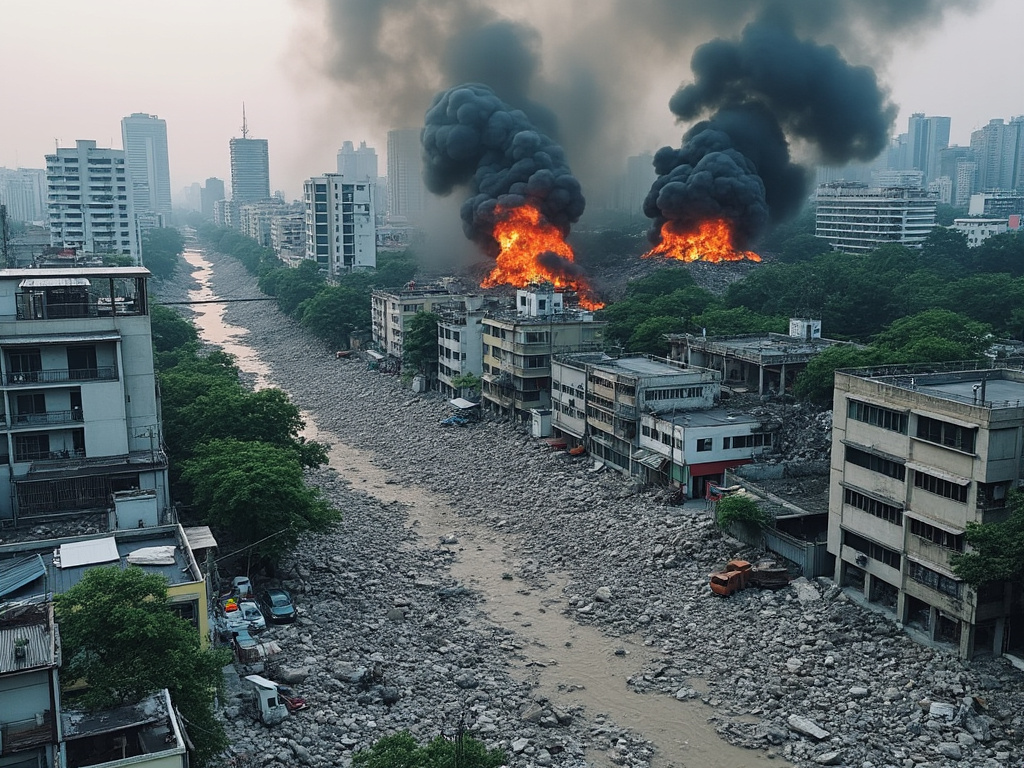
A powerful 7.7-magnitude earthquake has left widespread destruction and initiated international aid efforts.
The death toll from the 7.7-magnitude earthquake that struck Myanmar and Thailand on Friday has surpassed 1,600, with rescue efforts ongoing in the most severely affected areas, particularly in Mandalay, Myanmar.
Rescuers are working to clear debris by hand to find victims trapped beneath collapsed structures.
Compounding the challenges, damaged roads, collapsed bridges, and power outages have hindered humanitarian efforts across a wide region.
In Thailand, rescue operations are focused on a 33-storey building in Bangkok that collapsed, burying up to 100 construction workers, many of whom are believed to be from Myanmar.
As the rescue window for survivors narrows, authorities reported ten deaths in Bangkok, primarily linked to the construction site collapse.
Signs of life have been detected beneath the rubble, raising hopes for possible rescues.
The earthquake, the most significant to affect both Myanmar and Thailand in recent history, was felt as far as Laos, China's Yunnan province, and Ho Chi Minh City in Vietnam, with significant tremors reported in each area.
According to Myanmar's ruling junta, the death toll from the earthquake has increased to 1,644, with 3,408 individuals injured and at least 139 reported missing.
General Min Aung Hlaing, the junta leader, acknowledged that the casualty figures could rise further as rescue operations continue, inviting international assistance for relief efforts.
The earthquake struck central Myanmar at approximately 1:40 PM local time, near the city of Monywa and close to Mandalay.
The tremors caused panic in the Thai capital, prompting citizens to evacuate malls and office buildings.
High-rise structures swayed, leading to spillage from rooftop pools onto the streets below.
In response to the scale of the disaster, international aid is being mobilized.
China dispatched an 82-person rescue team to Myanmar, with additional units from Yunnan province arriving in Yangon.
The Chinese government announced a commitment of US$13.8 million in emergency humanitarian assistance, with shipments set to commence shortly.
Hong Kong also contributed, sending a 51-person rescue team along with essential equipment, including search dogs and life detectors.
Rescuers are working to clear debris by hand to find victims trapped beneath collapsed structures.
Compounding the challenges, damaged roads, collapsed bridges, and power outages have hindered humanitarian efforts across a wide region.
In Thailand, rescue operations are focused on a 33-storey building in Bangkok that collapsed, burying up to 100 construction workers, many of whom are believed to be from Myanmar.
As the rescue window for survivors narrows, authorities reported ten deaths in Bangkok, primarily linked to the construction site collapse.
Signs of life have been detected beneath the rubble, raising hopes for possible rescues.
The earthquake, the most significant to affect both Myanmar and Thailand in recent history, was felt as far as Laos, China's Yunnan province, and Ho Chi Minh City in Vietnam, with significant tremors reported in each area.
According to Myanmar's ruling junta, the death toll from the earthquake has increased to 1,644, with 3,408 individuals injured and at least 139 reported missing.
General Min Aung Hlaing, the junta leader, acknowledged that the casualty figures could rise further as rescue operations continue, inviting international assistance for relief efforts.
The earthquake struck central Myanmar at approximately 1:40 PM local time, near the city of Monywa and close to Mandalay.
The tremors caused panic in the Thai capital, prompting citizens to evacuate malls and office buildings.
High-rise structures swayed, leading to spillage from rooftop pools onto the streets below.
In response to the scale of the disaster, international aid is being mobilized.
China dispatched an 82-person rescue team to Myanmar, with additional units from Yunnan province arriving in Yangon.
The Chinese government announced a commitment of US$13.8 million in emergency humanitarian assistance, with shipments set to commence shortly.
Hong Kong also contributed, sending a 51-person rescue team along with essential equipment, including search dogs and life detectors.




































